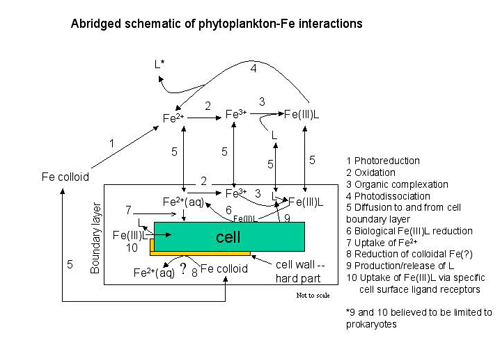
Agency:
Collaborators:
Morel Lab Participants: Adam Kustka, Yeala Shaked, Madeli Castruita, Eric Egleston
After a hiatus of several years (during which iron became the fashionable element in oceanography), we have reactivated our research on the iron physiology of marine phytoplankton. Our present foci are the mechanism of uptake of iron complexed in organic chelates or precipitated as colloidal oxides (the major form of iron in the oceans), and intracellular Fe storage. 1) Fe uptake. We have known for some time that diatoms are able to reduce Fe(III) and release Fe(II) from a variety of compounds, and that the “ferric chelate reductase” system is also capable of reducing Cu(II) compounds. The apparent lack of substrate specificity of the ferric chelate reductase system may be explained by the liberation of a diffusible reductant, as an alternative to the classical view of “lock and key” type enzyme-substrate interactions. We are currently investigating the mechanism of Fe reduction in diatoms and other groups. 2) Fe storage. We have identified in the recently published genome of the marine cyanobacterium Trichodesmium two sequences with high homology to genes known to code for ferritin, the major iron storage protein in living organisms. This is the first evidence of ferritin in marine microorganisms and we are in the process of isolating and characterizing this protein to study its role in the ecology of Trichodesmium, the organism thought to be responsible for the bulk of N2 fixation in the ocean.

